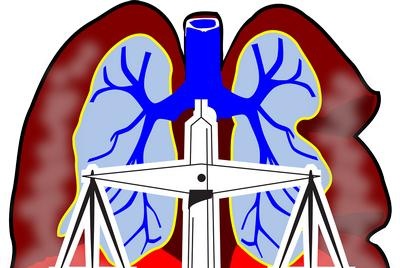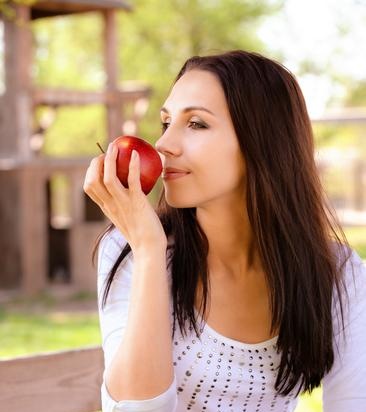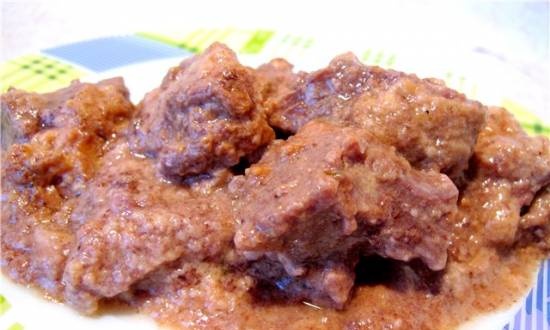|
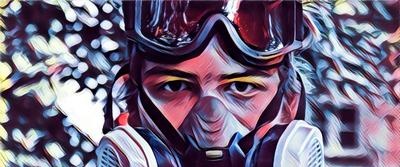 Respiration is a set of vital physiological processes occurring in the human body. Thanks to them, the body absorbs oxygen from the air and releases carbon dioxide. And oxygen, as you know, is a source of energy. Respiration is a set of vital physiological processes occurring in the human body. Thanks to them, the body absorbs oxygen from the air and releases carbon dioxide. And oxygen, as you know, is a source of energy.
With its help, the oxidation of nutrients entering the body takes place, the energy necessary for life is released.
The oxygen contained in the air through the respiratory tract (nose, pharynx, larynx, trachea, bronchi, bronchioles) enters the lungs, then passes into the blood, is delivered to the tissues, passes through the walls of the capillaries into the interstitial fluid and is utilized by the cells. Carbon dioxide, in turn, enters the blood from the tissues, then to the lungs and passes into the alveolar air, the composition of which is maintained at a certain level due to ventilation of the lungs. Such an interconnected exchange of gases in the human body can be schematically represented in the following sequence: external (pulmonary) respiration, gas exchange in the lungs, gas transport by blood, gas exchange between capillary blood and body tissues, intracellular (tissue) respiration.
External respiration - the renewal of air in the lungs - occurs due to respiratory movements, which are carried out by the intercostal muscles and the diaphragm. Air enters the lungs through the airways, passes through the bronchi and reaches the alveoli. They are densely entwined with capillaries. Here, gas molecules pass into the blood and back into the air. The total surface of all alveoli is more than 100 m2, which is approximately 50 times the surface of the human body.
An important indicator of respiration is the vital capacity of the lungs (VC). This is the amount of air that a person can exhale after taking a maximum breath. The value of VC depends on the sex, age and fitness of a person, the development of his respiratory system and other factors. In adult men, the average VC is 3500-4000 ml, and for women, 2500-3500 ml. Until the age of 18, the value of VC increases, in the period from 20 to 40 years, it almost does not change, and then begins to decrease with age.
Exercise helps to increase the values of VC. Especially high values of VC are observed among athletes involved in the so-called cyclic sports: rowers, skiers, middle and long distance runners, skaters, cyclists. On average, they have 4,700-5,300 ml. But the highest values of VC are observed in swimmers, in whom it reaches 6000-7000 ml.
VC is determined using a spirometer.
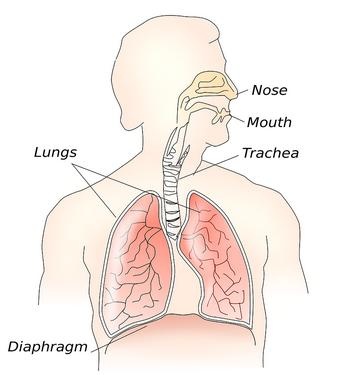 Thanks to the respiratory movements, constant ventilation of the lungs is carried out. The indicator of pulmonary ventilation is the minute volume of respiration (MRV) - the amount of air passing through the lungs in one minute. At rest, the MOD is 5-8 liters, and with physical activity it increases and can reach 150-180 liters per minute. Thanks to the respiratory movements, constant ventilation of the lungs is carried out. The indicator of pulmonary ventilation is the minute volume of respiration (MRV) - the amount of air passing through the lungs in one minute. At rest, the MOD is 5-8 liters, and with physical activity it increases and can reach 150-180 liters per minute.
In the alveoli, as already noted, there is an exchange of gases between the outside air and blood. Venous blood gives off carbon dioxide (carbon dioxide) and, being enriched with oxygen, turns into arterial.
Oxygen in the blood is in a dissolved state and in a chemical bond with hemoglobin, forming oxyhemoglobin. Most of the carbon dioxide is carried in the blood in a chemically bound state. The transport of oxygen and carbon dioxide by the blood is interconnected.
Usually, a person at rest consumes 200-300 ml of oxygen in one minute. During muscular activity, oxygen consumption increases from 4-5 and even up to 6 liters per minute. And this is natural. Muscular work is inconceivable without an increase in gas exchange, since energy is obtained in the process of oxidation of organic substances.Even with physical activity performed by small muscle groups, breathing changes are clearly expressed. With light work, the exchange of gases in comparison with the level of rest increases 2-3 times, with heavy work - 20-30 times. It should be borne in mind that the activity of oxidative processes is the higher, the greater the power of the work performed. Much also depends on the coordinated activity of the functions of respiration, blood circulation and the blood system. Complete mobilization of these physiological systems occurs 3-4 minutes after the start of muscular activity.
An important indicator of the body's ability to provide itself with oxygen during work is the maximum oxygen consumption (MOC). This is the largest amount of oxygen that the body can consume during intense muscular work. BMD serves as an indicator of the aerobic performance of the body, i.e., the ability to perform long-term work of low intensity.
In untrained persons, the IPC is equal to 2-3.5 liters per minute, and in athletes it can reach 5-6 liters per minute. Since BMD depends on body size, not only the absolute value of the indicator is taken into account, but also the relative one. In untrained persons, the IPC per 1 kg of body weight is on average 40 ml, and in athletes it reaches 80-90 ml.
The amount of oxygen required for oxidative processes that provide this muscle work is called oxygen demand. Distinguish between total and
minute oxygen request. The total oxygen demand is the amount of oxygen required to complete all the work, and the minute oxygen demand is the amount of oxygen required to complete the work in 1 minute. With an increase in the operating power, the minute oxygen demand increases, and with an increase in the operating time (at constant power), the total oxygen demand increases.
If in the process of work the oxygen demand is not fully satisfied, then an oxygen debt arises in the body. It depends on the power and duration of work. In case of accumulation of maximum oxygen debt, the body cannot perform work with the same capacity. After working during the recovery period, the oxygen debt is paid off. After a little muscle work, it is eliminated in a few minutes, after a long and intense load - in a few hours.
The maximum oxygen debt characterizes the body's ability to work with anaerobic energy sources and is an indicator of anaerobic performance. If in untrained people the value of the maximum oxygen debt does not exceed 5-7 liters, then in high-class athletes it reaches 20-21 liters.
With significant physical exertion, pulmonary ventilation increases and can reach 150-180 liters per minute, and sometimes more. Along with this, the penetration of oxygen into the blood increases. From each liter of inhaled air more oxygen is utilized (4-6%) than at rest (3-4%). This is facilitated by deeper breathing, which is considered optimal with 40-70 respiratory movements per minute. More frequent breathing does not provide adequate ventilation and oxygen consumption.
 The person usually breathes through the nose. From a hygiene point of view, this is quite justified. The air, passing through the narrow winding nasal passages, is warmed up, moistened, cleaned of dust. However, it should be noted that the resistance to breathing through the nose is 2-2.5 times greater than through the mouth. Therefore, if during a small physical activity, for example, when jogging, you can breathe as calmly as during ordinary walking, then the time of intense muscle work, in particular during fast running, when the nasal mucosa due to more abundant blood supply and increased function the mucous membranes seem to swell, it becomes impossible to breathe only through the nose. And to support on The person usually breathes through the nose. From a hygiene point of view, this is quite justified. The air, passing through the narrow winding nasal passages, is warmed up, moistened, cleaned of dust. However, it should be noted that the resistance to breathing through the nose is 2-2.5 times greater than through the mouth. Therefore, if during a small physical activity, for example, when jogging, you can breathe as calmly as during ordinary walking, then the time of intense muscle work, in particular during fast running, when the nasal mucosa due to more abundant blood supply and increased function the mucous membranes seem to swell, it becomes impossible to breathe only through the nose. And to support on
a proper level of pulmonary ventilation, it is advisable to inhale air simultaneously through the nose and half-open mouth.If the pace of running is not too high, then it is better to inhale through the nose and exhale through the mouth.
When doing physical exercises, it is recommended to breathe deeply and rhythmically enough, with an emphasis on exhalation. This helps remove air from poorly ventilated lower lungs. People who systematically go in for running gradually develop a certain rhythm of breathing, corresponding to the pace of steps. The number of steps for each inhalation and each exhalation ranges from two to four.
Systematic physical exercises have a very positive effect on the respiratory system, noticeably strengthen and improve its activity. There is a significant development of the respiratory muscles. The vital capacity of the lungs increases, which can reach 5000-7000 ml. The so-called vital indicator also increases - the value of VC, calculated per 1 kg of body weight. The indicators of the maximum oxygen debt also increase.
It is especially important to note the economization of respiratory functions. Thus, at rest there is a decrease (6-8 breaths per minute) and an increase in the depth of breathing to 700-800 ml. When performing standard work in trained people, a more rapid normalization of the respiratory function is observed. But during extreme work, highly trained athletes, thanks to their large breathing reserves, can consume up to 5-6 liters of oxygen per minute.
So, systematic physical exercises are an excellent means of strengthening the respiratory system, ensuring human health and performance. And the most effective in this regard are swimming, jogging, skiing, rowing, cycling, skating, nordic walking.
What we breathe in the kitchen
Hygienists have determined the content of toxic products of incomplete and complete combustion of gas in the air of an ordinary home kitchen. The measurements were carried out in different conditions - with open and closed doors, vents, ventilation devices, with the fan turned on and off. It turned out that if the kitchen is not ventilated, the concentration of harmful substances in it after two hours of burning two gas burners is 6-7 times higher than the maximum permissible concentration for the working areas of industrial premises. Studies have shown that the best way to clean the air in the kitchen is a simple measure - keeping the window open all the time the gas is on.
A. Laptev
|
 Respiration is a set of vital physiological processes occurring in the human body. Thanks to them, the body absorbs oxygen from the air and releases carbon dioxide. And oxygen, as you know, is a source of energy.
Respiration is a set of vital physiological processes occurring in the human body. Thanks to them, the body absorbs oxygen from the air and releases carbon dioxide. And oxygen, as you know, is a source of energy. Thanks to the respiratory movements, constant ventilation of the lungs is carried out. The indicator of pulmonary ventilation is the minute volume of respiration (MRV) - the amount of air passing through the lungs in one minute. At rest, the MOD is 5-8 liters, and with physical activity it increases and can reach 150-180 liters per minute.
Thanks to the respiratory movements, constant ventilation of the lungs is carried out. The indicator of pulmonary ventilation is the minute volume of respiration (MRV) - the amount of air passing through the lungs in one minute. At rest, the MOD is 5-8 liters, and with physical activity it increases and can reach 150-180 liters per minute. The person usually breathes through the nose. From a hygiene point of view, this is quite justified. The air, passing through the narrow winding nasal passages, is warmed up, moistened, cleaned of dust. However, it should be noted that the resistance to breathing through the nose is 2-2.5 times greater than through the mouth. Therefore, if during a small physical activity, for example, when jogging, you can breathe as calmly as during ordinary walking, then the time of intense muscle work, in particular during fast running, when the nasal mucosa due to more abundant blood supply and increased function the mucous membranes seem to swell, it becomes impossible to breathe only through the nose. And to support on
The person usually breathes through the nose. From a hygiene point of view, this is quite justified. The air, passing through the narrow winding nasal passages, is warmed up, moistened, cleaned of dust. However, it should be noted that the resistance to breathing through the nose is 2-2.5 times greater than through the mouth. Therefore, if during a small physical activity, for example, when jogging, you can breathe as calmly as during ordinary walking, then the time of intense muscle work, in particular during fast running, when the nasal mucosa due to more abundant blood supply and increased function the mucous membranes seem to swell, it becomes impossible to breathe only through the nose. And to support on